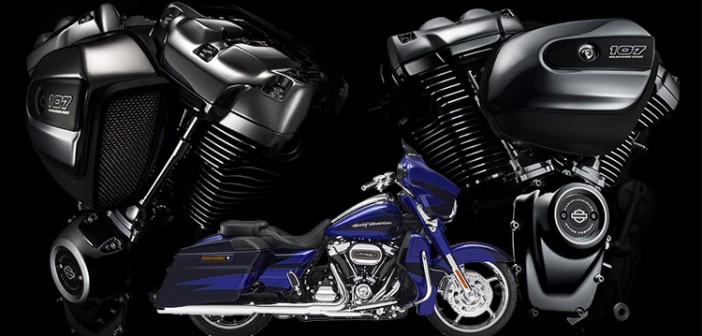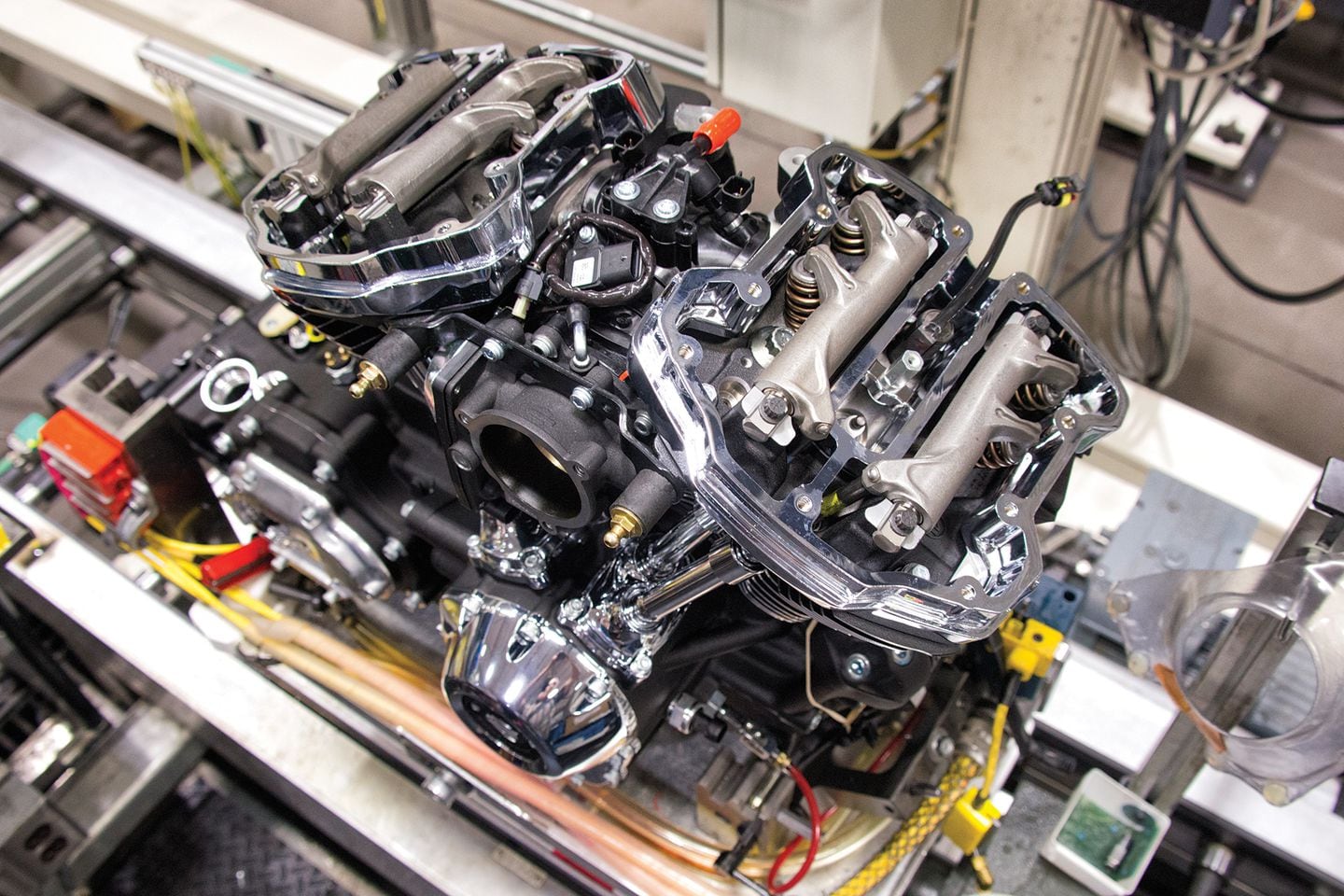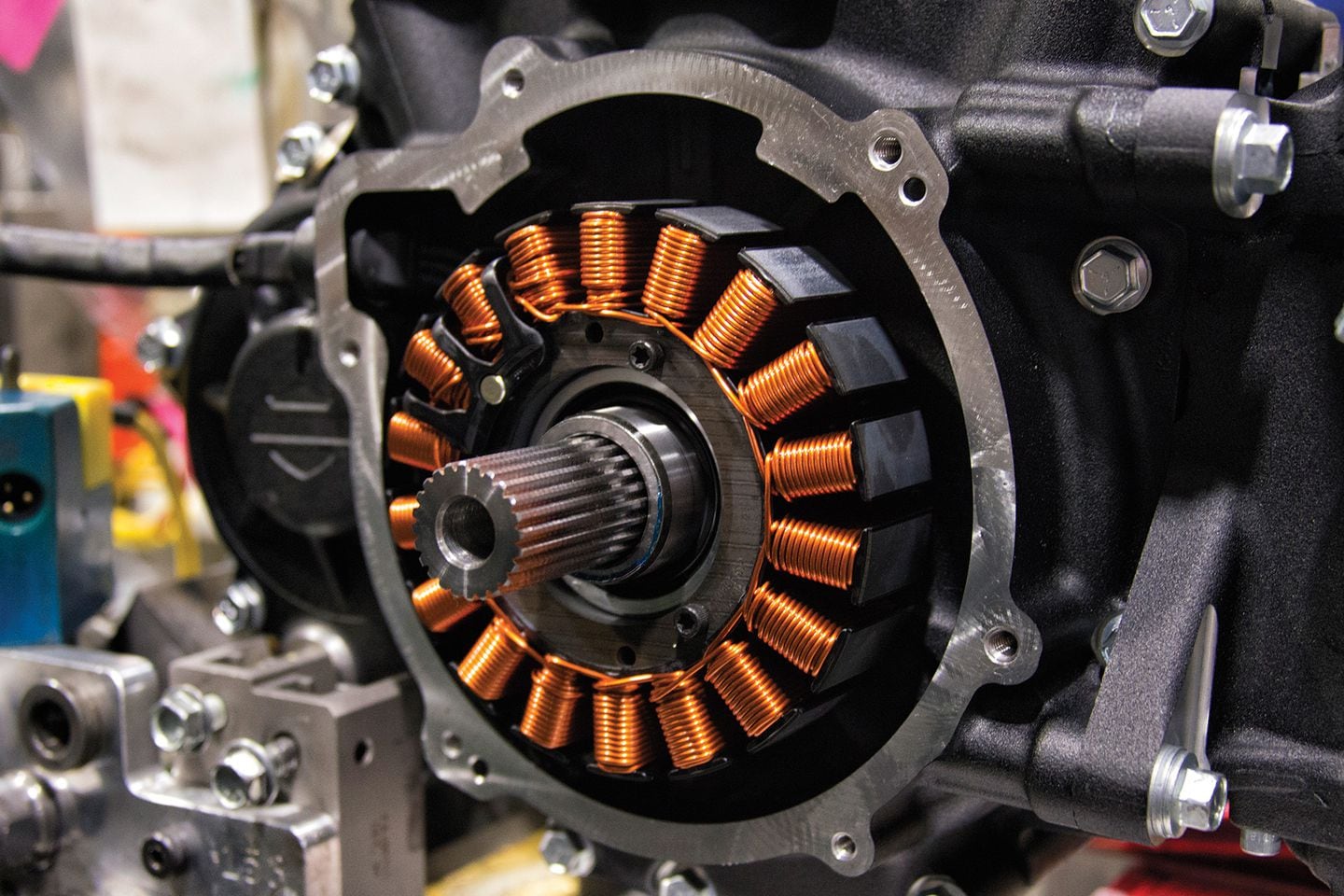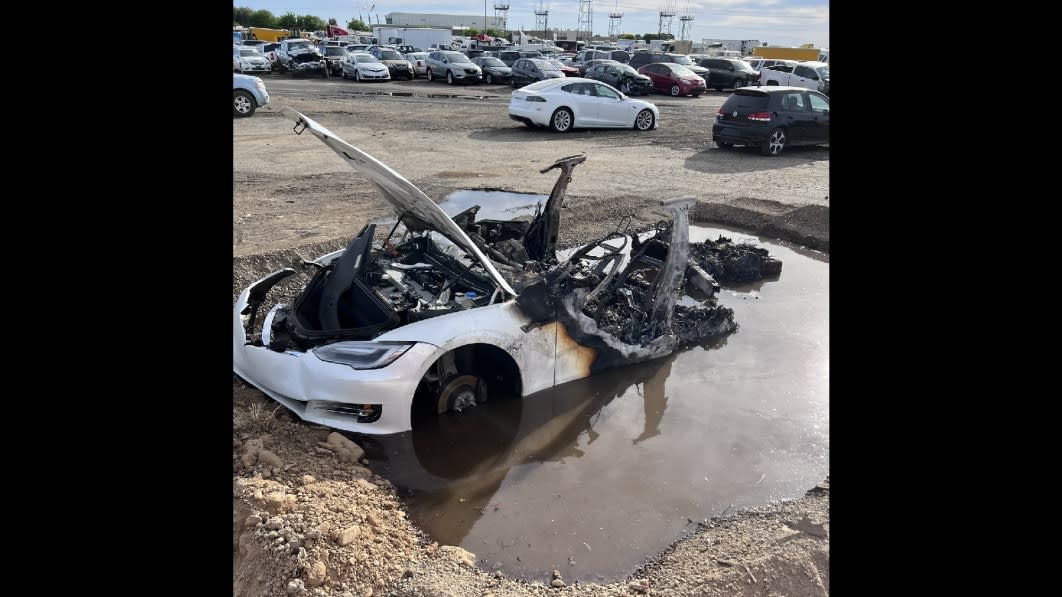New Mars Forums
You are not logged in.
- Topics: Active | Unanswered
Announcement
#201 2022-05-17 21:12:18
- SpaceNut
- Administrator
- From: New Hampshire
- Registered: 2004-07-22
- Posts: 30,109
Re: Fixing Americas car industry
We knew that states would get around to this one day Owners of electric vehicles, hybrids may have to pay an annual fee to use Louisiana roads
For those not bikers.

https://en.wikipedia.org/wiki/Harley-Da … ght_engine
https://www.harley-davidson.com/us/en/s … p/16200521
https://www.cycleworld.com/harley-david … in-engine/
engine assembly in process
end view of alternator
Offline
Like button can go here
#202 2022-05-19 13:49:11
- Mars_B4_Moon
- Member
- Registered: 2006-03-23
- Posts: 9,776
Re: Fixing Americas car industry
World's Fastest Electric Car Charger Installed in Norway - Full charge in 15 minutes
Offline
Like button can go here
#203 2022-05-20 16:48:34
- SpaceNut
- Administrator
- From: New Hampshire
- Registered: 2004-07-22
- Posts: 30,109
Re: Fixing Americas car industry
Sure fast but not cheap. The US may have a chance to get off the import of the very materials that make it possible.
The company references a 2022 feasibility study, with further research ongoing. It was already planning on pulling niobium, scandium and titanium out of the ground south of Tecumseh.
California's electrical grid has an EV problem
the additional load from electric vehicle (EV) charging could add more strain to the electric grid.
“Today’s grid may not be able to support it. It all boils down to: Are you charging during the time solar power is on?”
California’s grid could face a potential shortfall of roughly 1,700 megawatts, which would affect the power supply of between 1 million and 4 million people this summer. That number would likely be exacerbated by an additional shortfall of 5,000 megawatts in the case of extreme heat and further fire damage to existing power lines.
Offline
Like button can go here
#204 2022-05-21 17:59:00
- SpaceNut
- Administrator
- From: New Hampshire
- Registered: 2004-07-22
- Posts: 30,109
Re: Fixing Americas car industry
Why Electric Car Battery Recycling Matters as Much as the Cars Themselves
especially for those that have had lots of bad units....that failed sooner than the expected 10 to 15 years for most.
Let's pin down some weights for major component in this 1018 Cold-Drawn Seamless (CDS) tubular chassis vehicle:
600lbs - 357 feet of 1.75"OD / 0.095" Wall 1018 / 1020 mild steel tubing; $332.01 at Stock Car Steel's website (we'll probably use more than one diameter of tubing for weight optimization, but this is the largest and most expensive stuff we'll use)
200lbs - Ford F-250 window glass ( 2 front windshields and 4 front passenger windows; we're going to use suicide doors for the rear to latch both doors to the pillar between the front and rear row of seats )
225lbs - 5 full size steel wheels and tires
104lbs - 4 lightweight Mazda Miata brake assemblies
72lbs - 6 NRG padded GFRP full-headrest bucket racing seats built to accept 4 or 5 point harnesses $1,860
30lbs - 6 Braum Racing 4-Point Harness (latch still operates like a normal passenger car seat belt) $600
200lbs - 121hp Harley-Davidson Milwaukee-8 131cid V-twin engine and transmission
60lbs - Ford Mustang Lightweight Manual Steering Column and Rack
9lbs - EPA / CARB compliant 12 gallon polymer fuel tank
72lbs - 12 gallons of gasoline
16lbs - All-steel door hardware (interior / exterior handles, locks, and latching mechanisms)
40lbs - Unidirectional Carbon or Kevlar fabric (NOT composite) over foam panels for body panels / skins)
100lbs - Misc (headlights / tailights / blinkers / wiring / floor mats)That puts us at 1,628lbs for a 6-seat wide body (as wide as a Ford F250) vehicle, meaning this vehicle will comfortably seat 6 passengers, 3-abreast. With a 700 pound load (mom and dad plus 4 kiddos), we're still at 104hp/ton. That's as good as or better than a 4,000 pound car with a V6 or battery electronic drive train and a 200hp engine. The NRG seats have a passenger weight limit of 240lbs or 265lbs, I forget which it is. You have electric window defrost and 2/40 AC, but no heat until I can devise a way to provide that without increasing weight too much. No radio, no electronic gimmicks, no "power everything", just a simple functional vehicle that burns a lot less gas idling in traffic, with reasonably peppy performance up to 75mph. We'll have to devise some mechanical hardware to manually adjust seat height and throttle / brake pedals to accommodate differently-sized drivers.
Offline
Like button can go here
#205 2022-05-31 21:07:40
- SpaceNut
- Administrator
- From: New Hampshire
- Registered: 2004-07-22
- Posts: 30,109
Re: Fixing Americas car industry
In GM's patent, one port allows 800V charging, while the other allows 400V charging. With some circuitry and switches and software, that allows the user and the vehicle to suddenly have several options for charging. Plug in one cord from one 350 kW charger and you're charging the whole pack, operating in series, at 800V. The secondary port is bidirectional, so you could also hook up another vehicle—say, an EV excavator with a smaller pack at a job site where chargers are limited—and you start to see how this could become very useful.
If a 350 kW fast-charger isn't available and you need lots of battery replenishment quickly, the tech could allow you to plug in two cords-like say from two 150 kW fast-charging towers-and run the pack in parallel mode, charging both at 400V.
Well the higher voltage means lower conductor size and amperage required to deliver power to the wheels...
Offline
Like button can go here
#206 2022-06-22 20:11:49
- SpaceNut
- Administrator
- From: New Hampshire
- Registered: 2004-07-22
- Posts: 30,109
Re: Fixing Americas car industry
Musk says Tesla's new car factories factories in Texas and Berlin 'losing billions of dollars'
For the Texas plant its production of its new "4680" batteries and as tools to make its conventional 2170 batteries are "stuck in port in China."
Tesla Model S catches fire three weeks after getting sent to junkyard

Offline
Like button can go here
#207 2022-06-25 17:44:15
- SpaceNut
- Administrator
- From: New Hampshire
- Registered: 2004-07-22
- Posts: 30,109
Re: Fixing Americas car industry
The Reason The Chevrolet Tahoe Hybrid Was A Failure it's hybrid version of the Chevy Tahoe was not cheap as the price started near $50,000.
ouch
The model's 6-liter V8 hybrid engine had better gas mileage than the normal Tahoe (which got 16 mpg at that time), but it lagged behind that of its hybrid competitors. Most hybrids from that era got around 50 miles to the gallon, but Chevy's then-new SUV only got 21 mpg (via Chevrolet).
Offline
Like button can go here
#208 2022-07-01 16:00:43
- SpaceNut
- Administrator
- From: New Hampshire
- Registered: 2004-07-22
- Posts: 30,109
Re: Fixing Americas car industry
No need for gasoline video of new-solar-powered-car-called-lightyear-can-go-months-without-plugging-in
next video is of a bike hybrid car
Offline
Like button can go here
#209 2022-07-01 16:16:17
- kbd512
- Administrator
- Registered: 2015-01-02
- Posts: 8,418
Re: Fixing Americas car industry
SpaceNut,
1. The link you posted doesn't work for me. I get redirected back to MSN news home.
2. I already posted about this vehicle and why it's a great idea, yet still falls squarely within the realm of utter nonsense for most people.
The car cost $265,000 USD, so you know, if you're looking to replace your Aston Martin or Ferrari with something "less costly to run", then this car is for you.
Offline
Like button can go here
#210 2022-07-01 16:22:28
- SpaceNut
- Administrator
- From: New Hampshire
- Registered: 2004-07-22
- Posts: 30,109
Re: Fixing Americas car industry
I remember now the ridiculous price tag for a car...
https://www.treehugger.com/lightyear-0- … dy-5498883
5 square meters of double-curved solar arrays that can charge the electric vehicle while it's driving or parked outdoors. The solar panels can add up to 43 miles (70 kilometers) of range a day in addition to its estimated 388 miles (625 kilometers)
The electric motors generate a combined 174 horsepower and 1,269 pound-feet of torque, which can accelerate the Lightyear 0 from 0-62 mph in 10 seconds and a top speed of 100 mph.With an energy use of 10.5 kWh per 62 miles (100 kilometers), Lightyear says it is the most efficient electric vehicle and its drag coefficient of less than 0.19 makes it the most aerodynamic family car yet. Although the Lightyear 0 is more than 16.4 feet long, it only weighs 3,472 pounds.
Offline
Like button can go here
#211 2022-07-01 22:54:01
- kbd512
- Administrator
- Registered: 2015-01-02
- Posts: 8,418
Re: Fixing Americas car industry
SpaceNut,
I kinda wonder if you had a large vehicle like a van with a series hybrid engine, could you power everything else and also recharge the small battery using the solar array to reduce the load on the engine or perhaps turn it off entirely during the daytime. This vehicle would have a very small battery pack, though, to keep weight sane.
The power-to-weight ratio is 100.23hp per American ton. If the vehicle wasn't lugging around a monster-sized 60kWh battery, then it could probably weigh half as much, so only 90hp. I'll wager that a Tesla vs a Nissan "e-POWER" producing only 90hp will lose the total energy consumption argument every single time. That'd put fuel consumption at 1.95L for 60 miles of range, or 17.16kWh. That's 177.7Wh/km. The Tesla is 250Wh/km. Performance would be no better or worse than Lightyear Zero.
You're obviously using more energy than Lightyear Zero, but the car won't cost $265,000, either.
Let's say our car cost $60,000, just to make it equal in cost to a Tesla Model 3. Hey, why not?
That buys 43,000 gallons or 162,773L of fuel at $5/gallon.
162,773L / 1.95L = 83,473.333
83,473.333 * 60 miles of range per 1.95L = 5,008,400 miles
It's about 238,900 miles to the moon, so we can afford to drive to the moon and back to Earth about 10.48 times for equivalent money spent.
According to Guinness World Records, a 1966 Volvo 1800S owned by a Mr. Irving Gordon, of East Patchogue, New York, holds the world record for mileage driven, at 3,400,000 miles and counting. I don't think I'll ever make it that far, but we can see how much more money is being spent on the EV.
I don't know what kind of magic fairy dust Lightyear Zero has been sprinkled with, but if it's my money I think I'd use all that leftover cash to pay for gas and call it a day. They spent big money to make their vehicle very light and aerodynamic, but then they immediately put a battery in it that weighs as much as a small car. I don't get it. I like the good aspects of the Lightyear Zero, but weight kills performance. There's no way that these people don't know this, but every one of these things weighs as much as a pickup truck. If the vehicle is intended to be driven 22 miles each way to work, then why not give it a 21kWh / 124 mile range so that the battery weighs no more than a combustion engine serial hybrid?
We could make these EVs quite practical by accepting range limitations or using serial hybrids. If 90% of real world driving is within 50 miles or less and you can recharge it in 15 minutes, then why does anyone care about range they're not using?
I don't care about the fact that a semi-truck can go farther than my car, because I won't sit on my butt for 10 hours per day.
If we're totally reliant upon electricity, mostly generated from fossil fuels, then it's sort of a use-lose proposition to anyway.
Offline
Like button can go here
#212 2022-08-06 17:15:42
- SpaceNut
- Administrator
- From: New Hampshire
- Registered: 2004-07-22
- Posts: 30,109
Re: Fixing Americas car industry
That free solar energy to charge a battery is coming just like the electric bike from Porche Solar Cars Are Coming, But at What Price -- and Are They Right for You?
Offline
Like button can go here
#213 2022-08-26 12:42:26
- Mars_B4_Moon
- Member
- Registered: 2006-03-23
- Posts: 9,776
Re: Fixing Americas car industry
Washington will ban new gas-powered cars in 2035, joining California
Offline
Like button can go here
#214 2022-08-26 19:38:20
- SpaceNut
- Administrator
- From: New Hampshire
- Registered: 2004-07-22
- Posts: 30,109
Re: Fixing Americas car industry
With all of the banning the price of gas will drop like a rock from all of the surplus that we will end up with.
In fact, it was 2 cents lower tonight as I went by the pump.
Offline
Like button can go here
#215 2022-08-26 19:46:58
- tahanson43206
- Moderator
- Registered: 2018-04-27
- Posts: 23,778
Re: Fixing Americas car industry
If Calliban has his vision come to life, no one will be driving a car anyway !!!
***
Over in the EV topic, Mars_B4_Moon found an MIT research announcement about a liquid battery (as you pointed out). I gather the system is best suited for a home or a small business, rather than a vehicle, but since the materials are common and available in the US, I would expect the new battery to enjoy rapid deployment as soon as the business is able to demonstrate reliable performance on an industrial scale.
(th)
Offline
Like button can go here
#216 2022-08-28 11:56:58
- Mars_B4_Moon
- Member
- Registered: 2006-03-23
- Posts: 9,776
Re: Fixing Americas car industry
Tesla will regain EV tax credit in 2023 — but may not need it
Offline
Like button can go here
#217 2022-09-18 11:52:42
- SpaceNut
- Administrator
- From: New Hampshire
- Registered: 2004-07-22
- Posts: 30,109
Re: Fixing Americas car industry
The Burnaby, British Columbia-based company said that - based on a pan-European diesel cost of $1.91 per litre on Sept. 5 and $10 per kg of hydrogen - a truck could travel just over 111 miles (179 km) on $100 worth of fuel using its new S1200 hydrogen fuel cell system versus a little over 109 miles for an equivalent diesel truck.
As the auto industry makes the shift to zero-emission electric vehicles (EVs), big freight truck makers like Daimler Truck and Volvo are investing heavily in hydrogen fuel cells to haul freight long distances because batteries weigh too much to make electric trucks viable.
Offline
Like button can go here
#218 2022-10-09 16:59:00
- SpaceNut
- Administrator
- From: New Hampshire
- Registered: 2004-07-22
- Posts: 30,109
Re: Fixing Americas car industry
Not a to unexpected happenings from a hurricane Flooded Tesla EVs From Hurricane Ian Exploding All Over Florida
In the aftermath of the devastating Hurricane Ian in Florida, things are going from bad to worse. The destruction is massive, and also ongoing. That’s because even though the hurricane occurred over a week ago, its after-effects are mounting. These include the instances of Tesla EVs exploding into flames around the state. The mixture of electricity and salt water leads to these latent fires.
Offline
Like button can go here
#219 2022-10-12 08:32:24
- Mars_B4_Moon
- Member
- Registered: 2006-03-23
- Posts: 9,776
Re: Fixing Americas car industry
Nissan pulls out of Russia, sells all assets to state for 1 Euro
https://www.foxbusiness.com/economy/nis … ate-1-euro
Last edited by Mars_B4_Moon (2022-10-12 08:32:36)
Offline
Like button can go here
#220 2022-10-12 21:36:26
- SpaceNut
- Administrator
- From: New Hampshire
- Registered: 2004-07-22
- Posts: 30,109
Re: Fixing Americas car industry
We know that heat is the killer for batteries and that fast charging was never a good thing for them.
Offline
Like button can go here
#221 2022-10-22 12:01:07
- SpaceNut
- Administrator
- From: New Hampshire
- Registered: 2004-07-22
- Posts: 30,109
Re: Fixing Americas car industry
Exploring Steve Sewarts link from gravity storage led me to a cake and eating it too where the higher energy costs allow for an even greater level of control to an industry that will struggle to get better foot holds with setting up independent charging stations
State regulators approve Eversource’s electric vehicle infrastructure plan
Offline
Like button can go here
#222 2022-10-26 19:51:32
- SpaceNut
- Administrator
- From: New Hampshire
- Registered: 2004-07-22
- Posts: 30,109
Re: Fixing Americas car industry
All wheel drive versus 2 wheels for electric only designs is maybe the next question as Are in-wheel motors the future of electric cars?
Offline
Like button can go here
#223 2022-10-26 20:14:48
- kbd512
- Administrator
- Registered: 2015-01-02
- Posts: 8,418
Re: Fixing Americas car industry
SpaceNut,
From the article:
This makes the car lighter, Ambrozic tells CNN Business, and it saves energy by reducing the distance the power has to travel. It also frees up space in the vehicle and allows the manufacturer to make the car more aerodynamic. A more aerodynamic vehicle in turn needs less power, which can mean smaller batteries and lighter vehicles, he adds.
That part in bold makes no sense at all. It's literally someone parroting back a talking point. There's no way this does anything for vehicle aerodynamics, one way or the other. Good aerodynamics would help with energy consumption, especially at high speed, but range is driving the battery weight.
Offline
Like button can go here
#224 2022-10-26 20:37:42
- SpaceNut
- Administrator
- From: New Hampshire
- Registered: 2004-07-22
- Posts: 30,109
Re: Fixing Americas car industry
Battery current and cable size contributed to power loss to the motor if its front wheel drive only due to the distance that power must travel without making that power cable differently from the back where the battery is located.
Short cables to each motor have less loss for each and power required for each motor is also less so it's a net savings as there is no transaxle to slip or waste energy in torque control to the wheel.
What drives the battery mass is current draw to the motors to accelerate and for energy coupling to the wheels through that transaxle if a cvt which slips and must be changed once you get up to speed by letting off the pedal and then reapplying it so as to set a different slipping ratio.
Offline
Like button can go here
#225 2022-10-27 00:00:27
- kbd512
- Administrator
- Registered: 2015-01-02
- Posts: 8,418
Re: Fixing Americas car industry
SpaceNut,
That statement makes no sense, unless the engineers intentionally put the location of the battery terminals away from the motor. You can put terminals to the battery on both ends if the car is AWD, towards the front of the car if it's FWD, or towards the rear if it's RWD. As such, the cables are not significantly shorter or longer in a properly designed setup.
Transaxle slip is "a thing" for accelerating around the corners. No energy is wasted if there's no slip, and when it's locked up there's no slip, but I'd bet it's not a lot of energy wasted even if it does, because that normally implies tight turns at low speed and hard acceleration through those turns. Real life driving seldomly includes hard acceleration through turns. There is no CVT in a Tesla, or transmission for that matter, so CVT slip doesn't apply at all.
Hub motors do significantly increase unsprung weight, which offers no tangible performance benefits that I'm aware of, and may hurt performance in most cases, because it makes the job of the suspension system more difficult when it comes to keeping the car planted on the ground to provide traction. Ride quality has to suffer by doing this, but these new EVs are so ridiculously heavy that the overall effect may be less noticeable. Specifically, unsprung mass decreases acceleration and increases braking distance. All other factors being equal, now you need heavier suspension and more powerful brakes to stop the car as well. Any weight and power loss you saved on very slightly shorter battery cables or a limited-slip transaxle is immediately added back, and then some, in the form of 8 vs 2 power cables which also lose voltage, heavier shocks, and heavier brakes.
These are simply out-of-context talking points with little to no meaning. This is the problem with non-engineers reporting "design magic", where there's no magic to be had. Everything is a trade-off. I don't see any worthwhile trade-offs here, but maybe that's because I'm looking at this from an overall engineering perspective and know enough to understand how silly these blanket statements are.
Offline
Like button can go here
